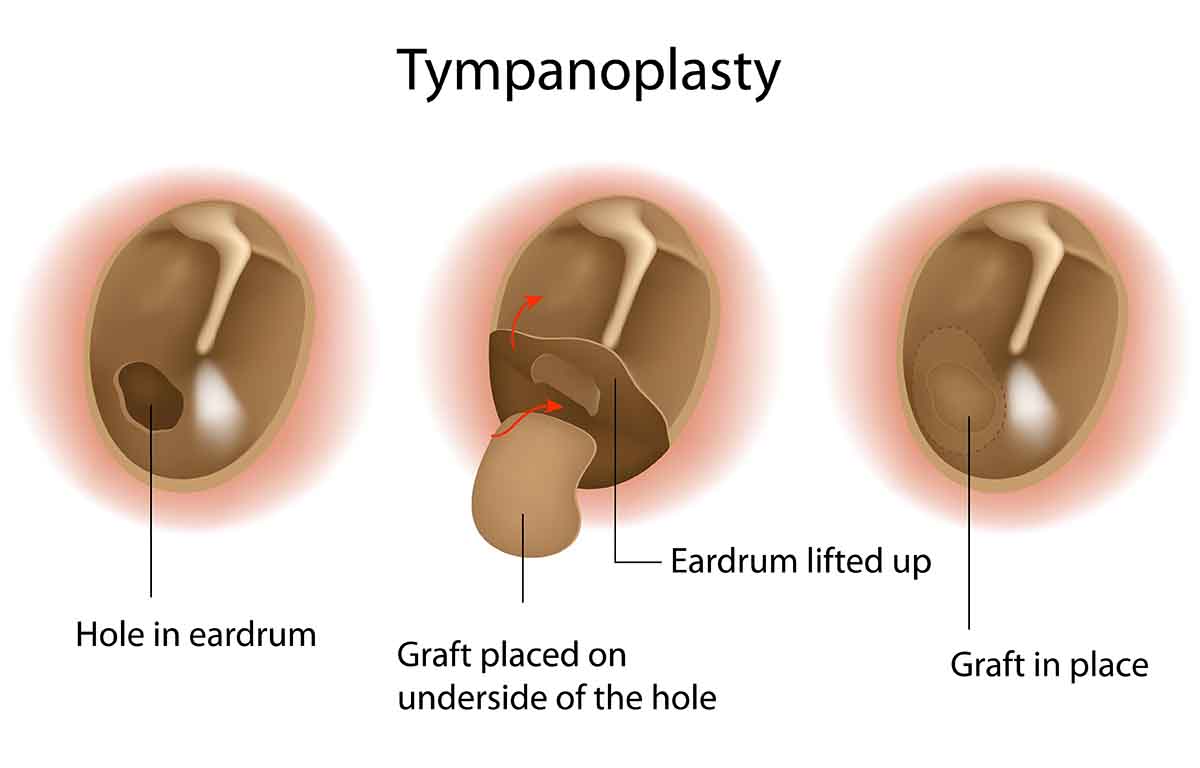Tympanoplasty Surgery
A tympanoplasty is a surgical procedure used to repair a torn eardrum, also known as the tympanic membrane.
A tympanoplasty is a surgical procedure used to repair a torn eardrum, also known as the tympanic membrane. The eardrum is a thin membrane in the middle ear that vibrates in response to sound. A tear or hole in this membrane may be caused by events such as trauma from sudden changes in pressure, recurrent ear infections, a cholesteatoma, or trauma from inserting foreign objects into the ear canal. In about 80% of cases, a ruptured eardrum will heal by itself without intervention. However, if this hole is unable to self-seal, it can lead to complications such as hearing loss or an increased risk of ear infections.

The Tympanoplasty Procedure
Tympanoplasty surgery is performed by an ENT (ear, nose, throat) surgeon, either with a microscope or an endoscope, a thin cable with a camera and a light.
Under general anesthesia, an incision is typically made behind the ear to create access for the surgical instruments to reach the eardrum. Depending on the location and size of the eardrum perforation, the surgeon may consider making the incision above the ear canal or even accessing the eardrum through the ear canal instead. If the ruptured eardrum requires only a very simple repair, this can sometimes be performed in the consulting room under local anesthetic.
A graft is used to patch over the hole in the eardrum, and packing material inserted around it to keep the graft in place. This graft can be healthy tissue taken from elsewhere in the ear, or made out of synthetic material. The incision is then closed and a protective dressing secured over the ear.
Depending on the complexity of the situation, such as the size and location of the perforation, and whether any other procedures need to be combined with the tympanoplasty, the operation may take anywhere from 30 minutes to several hours. Most patients can expect to go home on the same day as their procedure.
Tympanoplasty Recovery
Most people are able to return to light activities such as school or deskwork within the week, though hearing in the affected ear may take a few months to recover fully. A guide to post-operation healing may include instructions such as:
- Avoid blowing your nose for 2 weeks
- Ensure your mouth is open when sneezing to reduce pressure through the ear
- Keep the affected ear dry, using a cotton ball smeared with petroleum jelly in your ear canal when showering or bathing
- Avoid swimming for up to 6 weeks
- Avoid contact sports, vigorous exercise, or heavy lifting for at least 2 weeks
The packing material inserted during the operation is expected to dissolve by itself over time. If any packing still remains at the review appointment, the surgeon can remove it.
Tympanoplasty Risks and Complications
The success rate of tympanoplasty surgery is over 93%. In cases where complications do occur, the most common cause is when the graft fails and the hole persists or reoccurs. Some patients find that their hearing is not improved despite the procedure, or may even deteriorate further.
Other less common complications include:
- Tinnitus
- Dizziness
- Damage to the facial nerve
- Loss of sensation in the outer ear
- Bleeding from the surgery
Using a certain type of graft (taken from the forehead) and being in good overall health (such as being a non-smoker and not having diabetes) decreases the risk of complications post-tympanoplasty.
